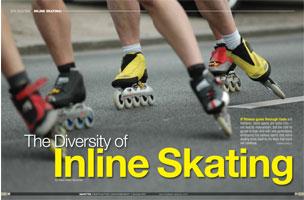
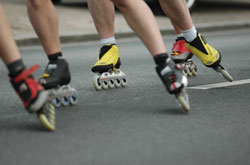 If fitness goes through fads and fashions, inline sports are boho-chic-not exactly mainstream, but too cool to go out of style. And with new generations embracing the various sports that inline skating lends itself to, it's likely that trend will continue.
If fitness goes through fads and fashions, inline sports are boho-chic-not exactly mainstream, but too cool to go out of style. And with new generations embracing the various sports that inline skating lends itself to, it's likely that trend will continue.
While the quad skate (the classic skate with four wheels set in two side-by-side pairs) continues to be the standard for roller derby, the introduction of the inline skate in the 1980s revitalized the industry, attracting a younger crowd. (The Rollerblade was the first mass-produced inline skate, and as a result, its name became synonymous in the public's mind with inline skating. However, Rollerblade is a trademarked term; there are other brands of inline skates on the market.)
Inline skating is diverse in its permutations, with athletes doing everything from figure skating to hockey, and everything in between. Some of the more popular competitive inline sports are mentioned below; however, others exist, as do some that are hybrids of two or more sports.
Currently, there are no inline Olympic sports. The national governing body for most inline athletics is USA Roller Sports (USARS).
On the Surface
Although it goes without saying, the safety of competitors should always take priority in the selection of a venue. Surfacing for areas being considered for inline competitions should be free of imperfections, such as cracks, dips, bumps or anything else that could cause a skater to trip and fall. (An exception to this rule would be the areas used for aggressive skating mentioned below, which are expected to have hazards and obstacles; however, the skating surface itself should still be safe and unblemished.)
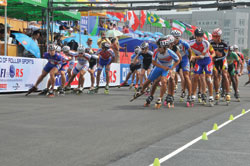 |
| Inline speed skating techniques, in many ways, resemble those used in bicycle racing. Skaters, like cyclists, will move in a pack, and will "draft" to lower air resistance. Note the plastic cones used to delineate the race course. Photo courtesy of MMJ. |
Depending upon the type of sport, inline-friendly facilities (other than skate parks and stunt areas) may be roller rinks, gymnasiums or arenas with coated wood floors or coated cement floors, as well as indoor multi-sport areas. Although asphalt or concrete tennis courts also have been used, it is generally accepted that this is not an ideal venue, as the surface of the court can sustain damage from wheels; these blemishes then present a hazard to other skaters. Over the years, special inline-specific sports surfaces and surface coatings have been developed.
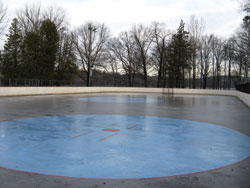 "Inline hockey is played at a high speed, and skateboarders and inline skaters going down ramps and back and forth from jumps also achieve a high speed," says Matt Hale of Halecon, Inc. in Bridgewater, New Jersey. "The surface is critical for both applications for both pace of play and safety. The slightest crack, bump or ridge can cause a tripping hazard, which is very dangerous. Due to the nature of these sports-hockey sticks constantly hitting the surface on the inline hockey, skate wheels skidding-the surface must be tougher than a standard acrylic surface used on tennis courts."
"Inline hockey is played at a high speed, and skateboarders and inline skaters going down ramps and back and forth from jumps also achieve a high speed," says Matt Hale of Halecon, Inc. in Bridgewater, New Jersey. "The surface is critical for both applications for both pace of play and safety. The slightest crack, bump or ridge can cause a tripping hazard, which is very dangerous. Due to the nature of these sports-hockey sticks constantly hitting the surface on the inline hockey, skate wheels skidding-the surface must be tougher than a standard acrylic surface used on tennis courts."
Types of Inline Sports
Aggressive Skating: Aggressive inline skating is an extreme sport, characterized by tricks and stunts. Skaters may perform tricks in a skate park (the term used is 'park' skating with obstacles including ramps, rails, jumps and more), in a half-pipe (vertical, or 'vert,' skating) and in an everyday (or 'street' skating) environment, in which skaters slide on handrails, jump down stairs, or use anything else readily available. Note: Skate parks, which vary in complexity and level of challenge, are made from wood, steel, fiberglass, composites and concrete. They may be either permanent (often, this type is constructed of concrete, although there are exceptions) or modular (constructed of wood, steel, fiberglass and/or composites).
Want a skater's-eye view of each? There are a variety of Internet web sites, forums and resources in which skaters 'rate' parks around the United States.
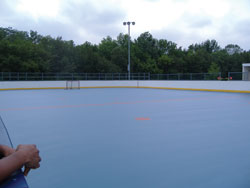 Hockey: Inline hockey is played both indoors and outdoors. It's a fast-paced sport, and the smoother and flatter the surface, the faster the game moves. The area required for use of an inline hockey rink is designated by the appropriate governing body. USA Roller Sports publishes a diagram and encourages users to refer to it, as does the Comite de International de Roller In-Line Hockey, or CIRILH. (Note: USARS rules and bylaws state that "Roller in-line hockey shall be played on wood, asphalt, cement or sport tiled floors or any appropriate surface approved by the CIRILH.”)
Hockey: Inline hockey is played both indoors and outdoors. It's a fast-paced sport, and the smoother and flatter the surface, the faster the game moves. The area required for use of an inline hockey rink is designated by the appropriate governing body. USA Roller Sports publishes a diagram and encourages users to refer to it, as does the Comite de International de Roller In-Line Hockey, or CIRILH. (Note: USARS rules and bylaws state that "Roller in-line hockey shall be played on wood, asphalt, cement or sport tiled floors or any appropriate surface approved by the CIRILH.”)
Freestyle: Freestyle skating is an umbrella term that includes both slalom (freestyle slalom and speed slalom), as well as jumps (free jump and high jump). A hard, flat surface is used for all competitions. According to information published on the website of the International Freestyle Skaters Association (IFSA), free jumping is done from the ground level over a bar that is set at specific heights for men and women, while in high jumping, the skater uses a ramp, also known as a jump board. With each successful jump, the bar is raised. IFSA also sets guidelines regarding the competition area for skaters in various disciplines. For example, in speed and freestyle slalom, IFSA specifies length and width of courses, and spacing of cones.
Inline Speed Skating: Inline speed skating is visually similar to the ice speed skating (short-track and regular) seen in Olympic competitions. In indoor venues, skaters move around a 100-meter track. The track area may be delineated with cones (again, similar to those used in ice racing). In outdoor venues, races may be held on streets that have been closed to traffic for the duration. There are downhill races and races that go along undulating roads. Paved park trails are also popular. An arena that has been built specifically for the purpose of inline racing is known as a patinodrome, and has an oval track, with flat straightaways and curves that are shallow-banked or not banked at all. They are common in Europe, but relatively rare in North America.
Inline speed skating may take many forms, including time trials, sprints, relays, distance races, marathons and more. The specific venue needed will depend upon the type of race, the number of skaters participating and other factors.
Inline Figure Skating: Inline figure skating is ice skating's counterpart. It is far less well-known, but has its own following, and competitive inline figure skaters may travel great distances to compete. According to the United States Federation of Inline Figure Skaters (USFIFS), categories within inline figure skating include freestyle, dance, synchronized skating and theater. As always, a smooth, safe surface is paramount in importance.
According to Joe Kaplenk, president of US Inline Figure Skating, "a performance rink should be about the size of an ice rink, which varies but is typically 85' x 185’. Roller rinks tend to be smaller, but not by much. Because dance patterns have to fall in a certain space, then something much smaller will not be usable for dance, but is okay for free skating practice, but not competition. There are requirements for competition in which the minimum is slightly smaller than the size of an ice rink and no maximum size. In some areas, but mostly overseas, people do use gymnasiums for inline figure skating and usually it works out well."
Ups and Downs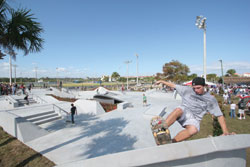 According to some sports builders, various types of inline facilities are more popular than others, and as a result, are better maintained. Builders caution planners to pick a facility with acceptable upkeep.
According to some sports builders, various types of inline facilities are more popular than others, and as a result, are better maintained. Builders caution planners to pick a facility with acceptable upkeep.
"In the mid to late 90s, inline skating rinks were becoming very popular in states where ice hockey was a major sport," says Michael Edgerton of DeRosa Tennis Contractors in Mamaroneck, New York. "Skateboard parks followed and are generally more popular now than inline skating. Unfortunately, the trend for inline hockey rinks that I see is that they are not as popular as they once were and are not being maintained and resurfaced as they should be."
Other Considerations
Define your needs: How much space is necessary?In hockey tournaments with multiple games, you’ll need multiple facilities. In any event with an elimination format, fewer facilities are needed over time. Warm-up or practice facilities for figure skaters may be desirable. Seek facilities with ample parking.
Equipment needs: Sticks, pads, helmets, skates, uniforms-hockey is an equipment-heavy sport, and property needs to be stored safely and conveniently. Figure skaters need places to store clothing, costumes, skates, etc. Freestyle equipment (cones, jump boxes, bars, etc.) must also be stored between uses.
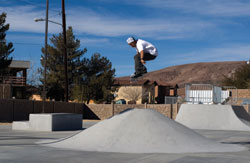 Seating: If this is a competitive event, and if it is not being held in a facility with bleachers, seating will need to be provided for spectators, teams, etc. ADA considerations apply.
Seating: If this is a competitive event, and if it is not being held in a facility with bleachers, seating will need to be provided for spectators, teams, etc. ADA considerations apply.
Conveniences: On-site rest rooms (or portable toilets and hand sanitizing stations) are necessary, as are changing areas and possibly refreshment stands.
Amenities: A public address system, score board,press box, etc. may be necessary.
Permitting: Make sure all necessary paperwork has been completed, including permitting for special events, road closures (for outdoor races), etc.
Insurance: In any sporting event, insurance is critical. Speak with your legal counsel and your insurance advisor, as well as the facility management, to make sure all appropriate coverage is in place.
Emergency Facilities: Skating injuries occur. Every venue should have a first-aid tent or office, and be accessible to emergency personnel.
The inline sports industry offers a lot of variety-and a lot of choices. With guidance from governing bodies, industry experts, and your clients themselves, you should be all lined up.

